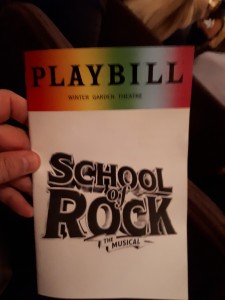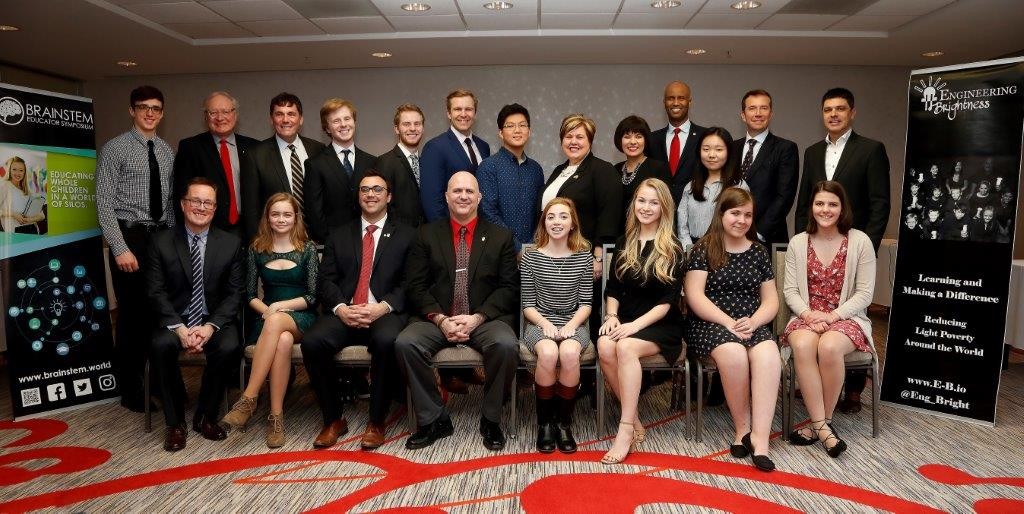The curtains rise to the first song which rocked the house! Despite all the lights, the music, jumping around, I saw a familiar look in his eyes as he rocked the guitar and the spot light changed from the first character to the him, the lead of a Broadway hit. He is living his dream. Every strum of the power chord was a friendly invitation to all those who thought his path was frivolous, to see him now.
Tonight, I went to see one of my previous students as the lead in “School of Rock” on Broadway. I was teary before it even began. Teaching is the most wonderful and important professions of all.

Ten years ago, this very energetic student took my high school physics class. While, he was personable, enthusiastic, respectful and made reasonable grades, he often seemed distracted and was distracting. Multiple times a week, he pestered me to go to the chem lab and “blow something up”. I finally had a few moments of sub crazy to take him to the lab. His eyes popped out of his head the first time we made a charcoal flare. I hoped this single outing had appeased his badgering. I was wrong.
The next day, his eyes told me he wanted to go back to the chem lab. It clicked in my head that there was something here. I took a breath, took a moment and pondered. How might I capture this spark, and personalize his learning to develop his passion. You see, the same talent and skill that was the Bain of many teachers’ classrooms, also made him a national level improv actor and coach.
“What if we did a chemistry road show? You could flip through this book of chemistry and physics demonstrations, learn the science, write a script, design some costumes, prepare the chemicals (under supervision), run some dress rehearsals and then actually take it on the road to the local elementary and middle schools.”
“We CAN? …YEAH!!” Within the week, he gathered a team of 5 around him and had written a first draft.
We spent a couple of lunches and after schools learning about endothermic and exothermic reactions, collision theory, the effect of particle size on kinetics, catalysts and thermodynamics. They spent much more time figuring out how to incorporate the demonstrations in to a cohesive, reasonable script, complete with considerations for showmanship and logistics.
I did not recognize then what I have since come to know as truth, “use areas of confidence to explore areas of uncomfortableness”. Like working out, learning is painful and scary. So, I used his confidence and passion for performing to teach the science that he was previously distracted to learn.
We had multiple successful performances that involved dry ice, liquid nitrogen, flames, smoke and discrepant events. On the last demonstration of our last performances, someone had not mixed the correct ratio of chemicals and it produced more smoke than expected. While there was no danger to the kids, the sports event that was scheduled for later that day had to be postponed.
I believe this had a positive impact on his final grades. While he knew the content of the Chemistry Road show inside and out, he also seemed to understand the rest of the content better too. I never had to worry about a distracted or distracting student, even when we were doing word problems.
One day as graduation approached, the grads were discussing the various paths and schools that each would pursue. He told the group that he was going to attend Second City in Chicago for improv. I congratulated him with enthusiasm; however, the whispers around the student tables and the staff room were largely something like, “go ahead, get that improv thing out of your system and we will see you after your gap year?” or “when will you grow up Peter Pan?” or “who does he think he is, going off to Second City..does he think he is good enough to be on SNL? Doesn’t he know he is from New Brunswick”
Facebook allowed me to keep infrequent and loose connection to him as he did dinner theater, improv, got a teacher’s license and even got married.
One evening just a year ago, I had a moment of déjà vu when I saw a car commercial. Surely that cannot be CJ. Come to find out not only was he in a couple of commercials, but he had some appearances in some TV episodes, had an animated series that he wrote picked up by NetFlix and was starring as the lead in School of Rock!!

Recently, I found myself on Broadway, skipping the long line up to pick up reserved tickets at the box office for School of Rock. It was a bit overwhelming walking into the theatre with the pressed tin ceilings, the red drapes, lineups at the concession stand. Ushers were directing people to their seats and the beautiful large red curtain with the snake and School of Rock logo. CJ’s picture and bio was front and center with super impressive bios of the other extremely well decorated veterans. He was in the spotlight surrounded by wonderfulness. As the guests file in, dressed in their Broadway best, you can hear the excitement in the voices of both the little kids and the adults. The magnitude and significance began to hit home. While others where talking about the rumours of how good he was, I was telling my colleague stories of his antics in class and using a flare to smoking out the elementary students. I was not sure that I had contributed in anyway to his success, yet I felt such a sense of fatherly pride because I was fortunate to witness his development first hand.
The curtains rise to the first song which rocked the house! Despite all the lights, the music, jumping around, I saw a familiar look in his eyes as he rocked the guitar and the spot light changed from the first character to the him, the lead of a Broadway hit. He is living his dream. Every strum of the power chord was a friendly invitation to all those who thought his path was frivolous, to see him now.
The lyrics that he sings parallel much of his high school experience. “At the top of Mount Rock, The doubters, and the Haters, and the hipsters let ‘em laugh, Soon they’ll all be begging for my roadie’s autograph. I know my time is coming, Well, hopefully its coming, I’m pretty sure its coming any day. Once they hear me Play !!! Then the dream that I had since the day I turned 10 will be finally coming true and no one’ll call me a loser again, or tell me what I can’t do. “
It is not lost on me the irony. One song talks about sticking it to the man, all the people trying to tell you what you can or cannot do, to put limits on your dreams and box you in. I laughed out loud. Later, in the parent’s night scene, he has to explain to the adults who are charged with developing kids into wonderful adults, to look beyond a score on a test about how intelligent and talented his students truly were. One of the songs (listen to me) behoves the adults to put away their preconceived notions of their kids and to take a moment, to breath and pay attention. “I’ve got so much inside, If only you would listen” “you just don’t want to see the real me… but I promise one day I’ll make you hear.”
The standing ovation started very early by all those around me and lasted a long time, confirmed that even those newly connected to him thought he was as awesome as I did. I am uncertain they had a tear falling of both cheeks like I did.

We waited outside the stage door for 30 min while the cast signed autographs for everyone, despite a physically and emotionally draining performance. A cast member comes out to the street and yells out my name over the noise of the crowd…Ian….Ian…. CJ wants you to come back stage. I arrive on stage in the middle of a photoshoot with fans. In the middle of the picture, he yells…”that is my physics teacher”. The picture is taken, he runs and jumps, feet off the ground into a huge hug. Laughing the whole way. He told everyone that he heard me laugh and pointed out where I must have been sitting. “It had been a long time since I heard Fogarty’s laugh.” After a pic on set, he showed me his dressing room, the same room that gave Linda Ronstat her start. He made it to the top of the Mount Rock.
We went out for something to eat and drink. The bouncers and waitresses all know him by name, and give him hugs, fist bumps …a la TV series Cheers. After a few minutes of speechlessness, I tell him how proud I am of him and I hope he is proud. His response will most certainly be a turning point in my career.
Some precursor. Over the past year and even just on the drive down to NY, I had talked with my car pooling colleague that I have been wondering about my effectiveness as a classroom teacher. While I am trying to be relevant and develop kids through teaching science, am I just transferring science knowledge? Should I continue teaching? Am I making a difference?
In the bar on 8th street, CJ said, you should be proud. My teachers did not know what to do with me. I was done my work, had lots of energy, lots of enthusiasm and personality. One teacher actually said, go back and put your head on the desk while you wait. Others did similar. But you were one of my seminal teachers. You took a moment, you listened, you saw my passion and created something for me.” There were other activities in school like student council, coffee houses and most importantly, IMPROV that allowed him to express himself. The Chemistry Road Show was the only place in school that embraced him and used his areas of confidence to explore uncomfortable learning. “I can still tell you about endo and endothermic reactions, kinetics, the recipes, the ratios and the procedure.” This was terribly encouraging to me. Personalization through contextualization.
Then he says, you care about your students and about your content. I still remember the day you talked about candles in space (microgravity) and time travel. He then proceeds to give details as evidence that this silly lecture I gave over a decade ago had stuck.
Conclusions… As I write this blog, I find it interesting that in some ways, maybe there are some small similarities between the way I teach science and the way School of Rock suggests education could be. Perhaps a book should be written that describes the educational philosophy that is hyperbolically described in the School of Rock. Aren’t there funny parallels to CJ’s life to those of his on stage students.
Do we provide time and space in our day, our curriculum and assessments to pause, listen to kids, see who they might be, see beyond what they might see for themselves and point them on their personalized way?






